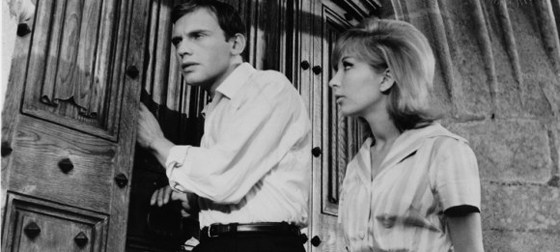Available on Blu-Ray from Mon 29 May 2017
Every now and then a vintage film is restored and given a new release to charm an all new generation of film fans. Occasionally, one of these films have the generation who were around at its original release looking baffled and shrugging. Georges Franju’s Spotlight on a Murderer is such a film, having shrunk into obscurity after a initial indifferent release. That it has been mostly forgotten until now is strange, it being the next film Franju made after the masterful gothic horror Eyes Without a Face, which is still justifiably celebrated.
Perhaps it’s relative anonymity is because Spotlight on a Murderer owes more to the conventions of Agatha Christie than it does to the likes of Horace Walpole or Sheridan Le Fanu and is a far less strange and hallucinatory affair than his masterpiece. The family of a wealthy French count arrive at his spooky medieval chateau for the reading of his will. However, they’re told that they have to wait five years for their inheritance as his body is missing. The count (a brief cameo by Pierre Brasseur) hid himself behind a two-way mirror in his room before expiring, in a secret compartment his family are unaware of. In order to raise money they decide to stage a lavish son et lumière to raise money for the upkeep of the chateau. One by one they begin to die.
It has to be said that by modern standards Spotlight on a Murderer comes across as a little staid, even quaint. This despite Franju’s beautiful, expressionistic visual style (this new restoration is gorgeously crisp) and the writing talents of Pierre Boileau and Thomas Narcejac (the source novels of classics Les Diaboliques and Vertigo) and the appearance of a young Jean-Louis Trintingnant (The Conformist, Amour). It comes into its own when the chateau is used to its potential, and the creepy old setting seems to have it in for its grasping, greedy new inhabitants.
Highlights are a scene in which an unknown presence sets off motion-sensitive lights in the control room one after the other, with Franju wringing impressive tension from such a simple set up; and the effectively staged light show outside the chateau proves the dramatic zenith. It’s a great little master class in how to make the best use of limited resources.
The film also has a streak of sly humour running through it. It comments on the very conventions it uses, from its very premise onwards. This humour is played very deadpan so as not to be too overt. This does give the result however, that it’s neither laugh-out-loud funny nor ever achieves the consistent tension of which Franju was so capable. That said, it’s an interesting curio that deserves a wider audience for its visual sensibility and some impressively stages scenes.
